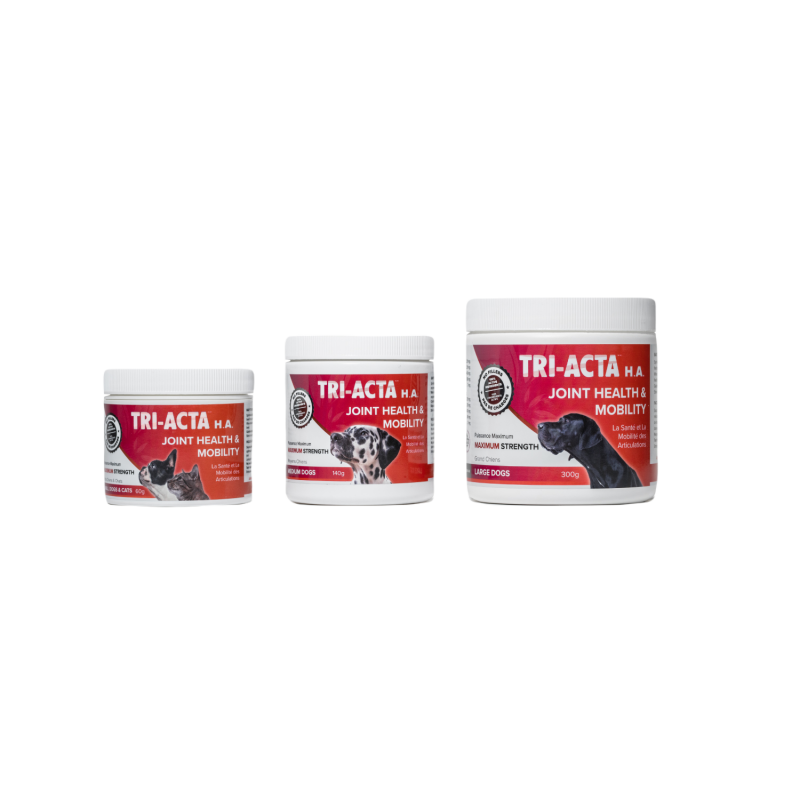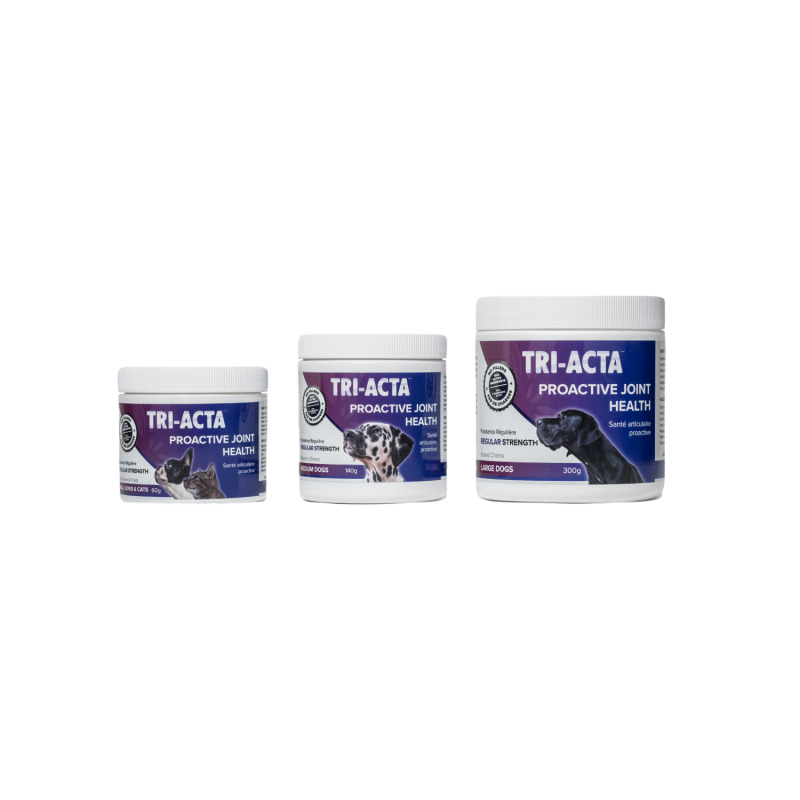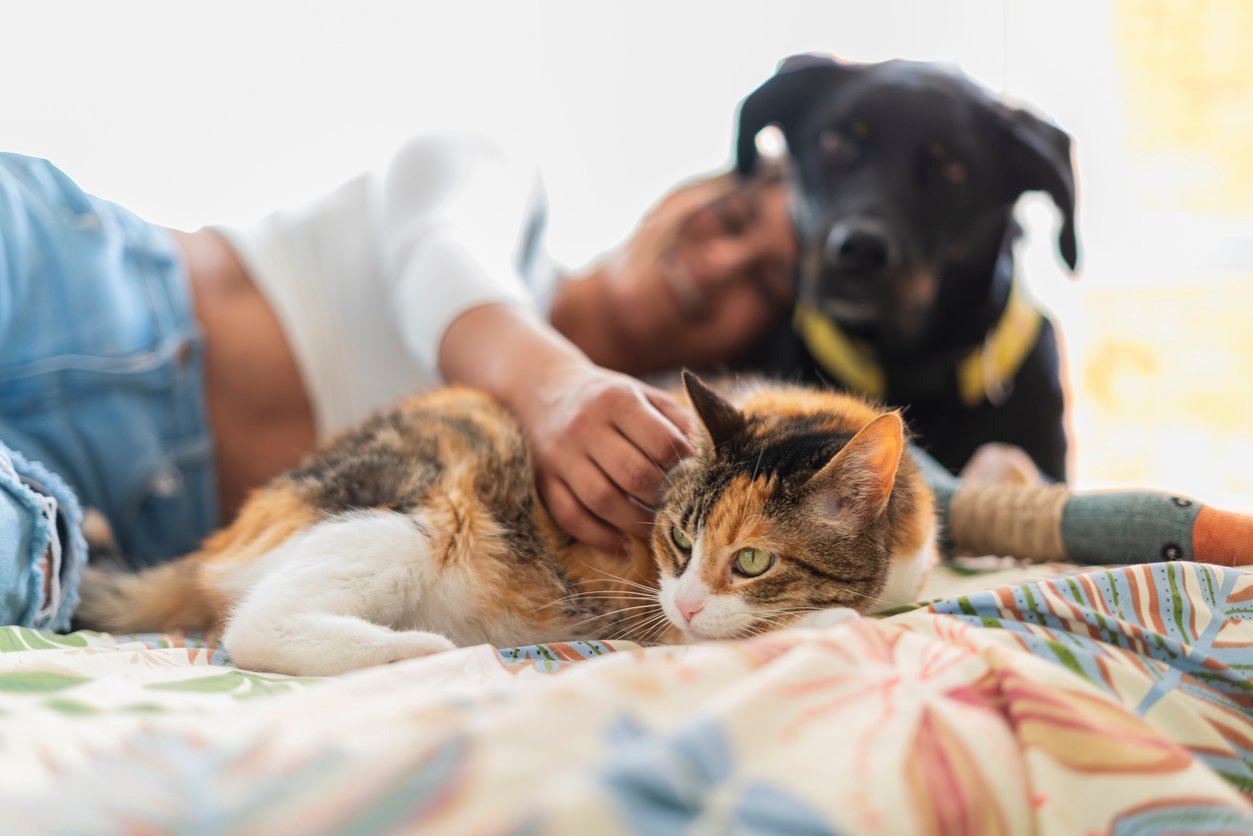Table of Contents
Keeping every member of our family happy and healthy, including our pets, is paramount. Our pet's needs differ from our own, so it’s important to be aware of these differences.
For example, cats need taurine in their diet because they cannot produce this essential chemical on their own. Therefore, you need to ensure that you feed your cat food containing taurine (all commercially available cat food contains taurine). On the other hand, dogs need a good balance of calcium, phosphorus, and vitamin D. Following pet food recommendations from a trustworthy authority on the subject is a good idea to ensure that your pet stays happy and healthy—after all, we are what we eat!
What is in your home is always a consideration as well. Certain plants, for instance, can be toxic to dogs and cats, so it’s important to ensure that you don’t have them in your house or yard. Keeping household chemicals locked safely away or put out of reach of your curious family members is also important.
Just like you would take the time to research, read reviews, and ask questions to choose the best family doctor for yourself and/or your kids, the same should be done for the pets in your house. The local vet that’s closest to your home might be a great option, but on the other hand, if you have a dog or cat with a unique health issue or condition, you might want to seek out a vet that’s more knowledgeable on the subject.
In this article, we explore more about family pet health, including common family pet health issues that you should know about and address, how to choose a family pet hospital that works for your pets, family pet health care tips, and more.
Family Pet Health Care: Needs Checklist + Benefits
Whether you’re bringing a new puppy or kitten into your home for the first time or you already have a menagerie of animals, understanding your pets’ health care needs is paramount. The first step to ensuring that your pets have their healthcare needs met is creating a pet wellness checklist.
This checklist should be divided into preventative pet health measures including annual veterinary services, as well as anything else you’d like to remember about your pet’s health, like food considerations, a list of safe plants to have in your home and your yard, and more. The following sections outline the key components that you should have on your needs checklist:
1. Vaccinations Schedule
For dogs, vaccines should be started when they are 6–8 weeks of age. These vaccines are divided into core and noncore, with core meaning that they are required for all dogs and puppies, while noncore vaccines are optional. Certain noncore vaccines are recommended depending on the lifestyle of your dog and their likelihood of being exposed to certain risks. For example, if your dog is usually outside, they are more likely to be exposed to a variety of bacteria. This means that your veterinarian will probably recommend the Leptospira vaccine, as it protects against the leptospirosis bacteria that is spread in water containing wild animal urine.
Along the same vein, if your dog goes to doggy daycare, grooming facilities, dog parks, and anywhere else where they will interact with a variety of different dogs, your veterinarian will likely recommend that you give them the Bordetella bronchiseptica (kennel cough) vaccine.
The table below outlines the different dog vaccinations and when they should be given to your dog. Some vaccines are listed more than once because they require more than one dose (booster) to be effective:
|
6–8 weeks old |
10–12 weeks old |
14–16 weeks old |
Annual vaccinations |
|
|
Core vaccines |
DA2PP* |
DA2PP* |
Rabies** DA2PP* |
Rabies** DA2PP* |
|
Noncore vaccines |
Bordetella Parainfluenza |
Leptospirosis Lyme Canine Influenza |
Leptospirosis Lyme Canine Influenza |
Leptospirosis Lyme Canine Influenza Bordetella |
*Stands for Distemper, Adenovirus I & II, Parvovirus, and Parainfluenza. Also sometimes referred to as a 5-way vaccine, because it’s a single shot that protects against all of these conditions.
**Rabies vaccine is required for dogs in certain parts of Canada where rabies is considered high-risk. For example, Ontario law states that all eligible pets must be vaccinated against rabies. In the United States, vaccine laws are similar in that they depend on the State’s laws and risk factors for the disease.
Cats have a similar vaccination schedule to dogs, where they should start getting their first vaccinations at about 6–8 weeks of age. These vaccines are also divided into core and non-core, but as you can imagine, the types of vaccines that are important for cats are very different. The noncore vaccines are also recommended to cats for different reasons compared to dogs as well. Really the only noncore vaccine for cats is the FeLV (feline leukemia virus), but it’s highly recommended, especially for kittens and for cats that often interact with other cats.
The table below lists the different types of cat vaccinations and when they should be given to your cat. The vaccinations are listed more than once because they require multiple doses (booster) to be effective. In certain situations, like if your cat is going to be boarded, a core vaccine booster may be recommended by your veterinarian up to 10 days before.
|
6–8 weeks old |
10–12 weeks old |
14–16 weeks old |
Annual vaccinations |
|
|
Core vaccines |
FVRCP |
FVRCP |
Rabies** FVRCP |
Rabies** FVRCP |
|
Noncore vaccines |
FeLV* |
FeLV* |
FeLV* |
FeLV* |
*The FeLV vaccine is highly recommended for kittens and adult cats that will often interact with other cats.
**Rabies vaccine is required for cats in certain parts of Canada where rabies is considered high-risk. In the United States, vaccine laws depend on the State and the cat’s risk factors for the disease.
2. General Health Maintenance
Aside from vaccinations, it’s also important to practice daily family pet health maintenance, including annual checkups at your veterinarian. If you’ve just brought your new pet home for the first time or you haven’t brought your pet to the vet in a while, the best place to start with family pet health care is a general checkup with your veterinarian. At this appointment, your vet will access the following to gather health information about your pet:
- Physical condition, including dental health, body condition score, quality of gait (walking), joint condition, and muscle condition
- Breathing patterns (your veterinarian will check your pet’s lungs and heart using a stethoscope)
- Overall behaviour, including potential indicators of poor health like aggression or lethargy
- Behavioural habits and tendencies, such as over-grooming in cats, repeated scratching, scooting, etc.
- General exercise level
- Eating and drinking habits
- Bowel movements and urination
From there, your vet can work with you to develop a plan for each of your pets that will maintain their overall health, from medications, food, and more.
3. Food
Choosing the right food for your pet can actually be a complex process. There are so many different varieties of commercially available pet food on the market, all claiming that they are the best options for our pets, that it can be tough to choose between them.
Most pet owners have heard of the fact that you should look for meat in the first three ingredients, but that’s not the only consideration:
- Statement of “nutritional completeness”: Depending on the life stage of your pet, they will have slightly different nutritional needs. Just like you’d feed a human child different portions and types of food (depending on their age) compared to an adult, your puppy or kitten needs different food as well. Commercially available pet food that’s suitable for daily feeding should have a statement of “nutritional completeness” or “adequacy” on the packaging, in addition to the life stage of your pet that it's appropriate for. If the food says that it’s a nutritionally complete food for puppies, then it will have a higher calorie count than adult dog food, for example. In some cases, food may be labelled as nutritionally complete for all life stages. If you purchase food with this statement, it means that it contains the correct balance of nutrients for your pet.
- Understand the way that ingredients are listed and what that means for the contents of the food: With pet food, ingredients are listed in order of quantity. What this means is that the first ingredient listed in the food is the ingredient that the food contains the most. However, the quantity of ingredients is also important to consider. If the food has 20 different ingredients, then that first ingredient being meat is going to mean less than if the food only has 10 total ingredients.
- Know the difference between meat, meat byproducts, and meals: Meat ingredients on pet food labels can be tricky, because they may say meat, but not actually contain all that much actual meat. To break it down, when the label says “meat” or “poultry” with no other words, that means it contains the flesh of the animal as well as any of its components, like sinew, gristle, or fat. If the label has “byproducts” after the meat or poultry, it means that it contains organs, fatty tissues, and bones, but not hair, fur, or feathers. With poultry, byproducts can also mean feet and heads. If the label says “meals”, then that means the food contains blood, hair, hooves, horns, and skin or hide. Byproduct meals are the furthest down the line of meat products. If byproduct meals are listed, it means the food can contain stomach contents, feathers, and even manure.
4. Supplements
In many cases, pets need supplements to keep them healthy and happy. The supplements you should give your pet heavily depend on their diet, health conditions, and overall lifestyle, but you can give your dog or cat a daily joint supplement regardless of their breed, activity level, or diet.
TRI-ACTA is a great choice for preventative joint support. Given that as many as 20% of dogs and 40–92% of cats (with advanced age being a big factor) suffer from some sort of joint condition at some point in their life, taking proactive action and giving your pet joint supplements is essential for their overall health.
TRI-ACTA is a unique offering in the market because it includes 100% natural and active ingredients, meaning your pet is getting the maximum benefit from the supplement without having to deal with fillers or additives, which as many as 50–80% of joint supplements for pets on the market contain.
TRI-ACTA contains the following ingredients:
Glucosamine Sulfate and HCl. Glucosamine sulfate provides sulfur to your pet’s joints, which is an essential component of their joint health. Glucosamine HCl is a highly bioavailable form of glucosamine, meaning that your pet’s body is able to absorb it and use it faster.
Chondroitin. Works together with glucosamine to support the repair and regeneration of cartilage in the joints.
Methylsulfonylmethane (MSM). A natural anti-inflammatory that works to reduce swelling and therefore pain in the joints, allowing for easier movement.
TRI-ACTA H.A. for Pets
Our maximum strength formula is optimally designed to accelerate the formation of cartilage, minimize inflammation, expedite the healing process, and improve joint conditions.

How to Choose a Family Pet Hospital
The next step for ensuring the health of your pets is choosing the right family pet hospital. Be sure to have all your pets' medical records handy and be prepared to answer any questions about their behaviour, diet, exercise level, and more when you meet a vet for the first time.
When researching veterinarians, it’s important to keep the following in mind:
1. The Family Pet Health Center’s Hours of Operation
It might not be the first thing you consider, but the hours of operation of the veterinarian you choose is an important thing to keep in mind. If you work during the day and the veterinarian closes at 5 p.m., for example, then if you ever need to take your pet there, you’ll need to be prepared to take time off of work. Depending on the size of the practice and the number of patients, some family pet hospital locations can be closed on weekends or on certain days during the week. It’s always a good idea to prioritize asking about hours of operation as one of the first questions you ask the vet as it may eliminate them as a solution immediately if their hours don’t jive with your schedule.
2. Reviews and Opinions from Other Pet Owners
The second best thing to do when choosing a family pet hospital is to do some research on the experiences that other pet owners have had with the facility. Most veterinary practices will have a website or other online presence like a social media account where people can leave reviews, but if you can, ask others in your local community about the family pet health center as well.
3. Payment and Insurance Options
Paying for family pet health care is also important. You may have pet insurance or you may not (pet insurance is always recommended, however), but regardless you should be aware of your veterinarian’s payment policies. Some family pet health facilities offer payment plans for larger procedures or emergency services that cost a lot of money, while others will expect payment in full on the spot. Being aware of these policies is important just in case. Plus, some veterinary offices are able to direct bill to insurance, while others require you to pay upfront and you are responsible for submitting the receipt to your insurance company. Whether you can directly bill or have to pay upfront may also depend on the type of pet insurance you have.
4. After-Hours Emergency Availability
Some family pet health facilities offer on-call services for emergencies, while others do not. It’s always important to have a plan of action just in case an emergency arises with your pet, so if the family pet health center does not offer emergency services, you’ll need to locate the closest one to you. Sometimes, veterinary facilities will have a partnership with other facilities that specialize in animal emergency care. In these cases, they can recommend an emergency facility to take your pet to should the situation arise. In addition, because of the partnership, records that detail the particulars of the emergency visit can be accessed by the original family pet health hospital so continuity of care can be maintained.
5. Veterinary Specialists
If you have a non-traditional pet like a reptile or have a dog or cat with special needs or a specific health condition, it’s worth asking if the family pet health facility employs specialists or handles referrals to specialists as needed. Like emergency services, some veterinary practices will have partnerships with specialists at other facilities that can handle certain illnesses or conditions that your pet may have.
Family Pet Health Care Tips at Home
There are a variety of ways that you can care for your pets at home aside from the standard feeding, playing, and giving them shelter. Some tips for keeping your pets happy and healthy at home include:
- Regular nail trimming and ear cleaning. Just like humans, our dogs and cats need to have their nails trimmed and ears cleaned occasionally. Thankfully, this is relatively easy to do at home. Avoid using Q-tips or cotton swabs in your pets' ears, as these can potentially cause damage if not used carefully and properly. Instead, use pet ear wipes or a clean cloth with some warm water and a pet-safe ear-cleaning solution. For nail trims, any pet clippers will work fine, just be sure to avoid cutting the quick of your pet’s nail.
- Ensuring that you only have safe plants in your home and yard. Some common household and yard plants, like Tulips, Lilies, and Azaleas are toxic to dogs, cats, and horses. It’s important to research any plant that you want to bring into your house or plant in your yard, as you never know if your pet will get curious about it and think it could be a delicious snack. It’s not unusual for dogs and cats to consume plants occasionally, especially grass, to either soothe their stomach or just because they feel like eating it.
- Expressing anal glands. Some dogs and cats may develop problems with their anal glands, although these problems are usually more common in dogs. When your pet’s anal gland fills up excessively, it can cause pressure, which is very uncomfortable for your pet. To relieve this pressure, your pet might “scoot” (rub their bum on a rug or other textured surface), lick the area excessively, or show obvious signs of discomfort when walking, sitting, or defecating. Redness and swelling around the area may also be present. Thankfully, there is a way to express these glands at home to relieve this discomfort. Using gloves, lift up your pet’s tail and pinch about an inch on each side of their anal opening using your index finger and thumb. Squeeze both sides until you see small amounts of liquid coming out. Gently wipe the area clean with a clean cloth with warm water or a paper towel.
- Bathing your pet. Sometimes it’s necessary to bathe your pet, either because they got into something or just because they get dirty over time. Typically cats don’t need to be bathed, but there also may be instances where you may have to do some bathing, like if they are a long-haired cat and get feces stuck to their fur. When bathing your pet, be sure to fill a bathtub with lukewarm water and use a pet-safe shampoo. For dogs and cats with fleas, making a soap ring around their neck before bathing helps prevent fleas from escaping to their face during a bath.
Best Family Pet Health Products
The following are recommendations for the best family pet health products that you can use to help keep your pet happy and healthy.
Best Joint Supplement: TRI-ACTA Products
TRI-ACTA products offer 100% active ingredients for maximum joint health benefits. With a small dosage of 1-2g for most dogs and even less for cats, it's easily mixed into their food. These unique animal supplements contain both sulfate and highly bioavailable HCl glucosamine, ensuring maximum benefit for your pet’s joints.
Integricare's dedication to quality has earned TRI-ACTA and TRI-ACTA H.A. approval as veterinary health products by Health Canada, meeting stringent criteria for manufacturing and ingredient quality.
TRI-ACTA for Pets
A proactive approach for developing and younger adult pets to maintain optimal joint health mobility, minimize inflammation and fend off age-related ailments.

Best Pet Shampoo: Earthbath Fragrance-Free Oatmeal & Aloe Shampoo
Our top pick for pet shampoo is Earthbath’s Oatmeal and Aloe Shampoo. This fragrance-free formula is great for relieving itchy skin and removing dirt thanks to the colloidal oatmeal and organic aloe vera. Plus, the shampoo is free from parabens, sulfates, or phthalates, ingredients that can cause irritation and skin reactions. It also lathers easily and isn’t scented, so you don’t have to worry about a strong scent affecting your pet.
$19.99 CAD. Pricing as of November 2023.
Best Pet Nail Clippers: Millers Forge Nail Clippers with Safety Stop
It can be tough to clip your pet’s nails, but these clippers make the job a bit easier. These are not a closed-circle or guillotine-style clippers, so they are easier to hold. Plus, they’re made of surgical-grade stainless steel and are very sharp, so they are able to cut through nails efficiently and effectively. They don’t block the view of the nail, so it’s easier to see your pet’s nails and avoid cutting the quick.
$10.26 CAD. Pricing as of November 2023.
Summary
It’s important to understand our pets' unique needs and provide them with everything they require to stay happy and healthy. Considerations like dietary requirements for cats and dogs, identifying toxic elements in the home, choosing the right veterinarian, and creating a pet wellness checklist are among the most important factors to keep in mind for your pet’s health.
In addition, knowing when to provide the right supplements is also important. Incorporating a joint supplement like TRI-ACTA into your pet’s daily diet can go a long way in ensuring their joints stay strong well into their golden years.
Purchase TRI-ACTA online or learn where to buy at a store near you.
TRI-ACTA H.A. for Pets
Our maximum strength formula is optimally designed to accelerate the formation of cartilage, minimize inflammation, expedite the healing process, and improve joint conditions.

Newsletter Signup
Subscribe to our newsletter to receive the latest news and exclusive offers.
.jpg?height=2000&name=Cliick_Integricare-DISPLAY-REVISEDV2%20(1).jpg)
Proactive & Therapeutic Joint Supplements
When given daily, Integricare joint supplements recover bone and joint injuries faster and help prevent mobility injuries from happening in the first place.











